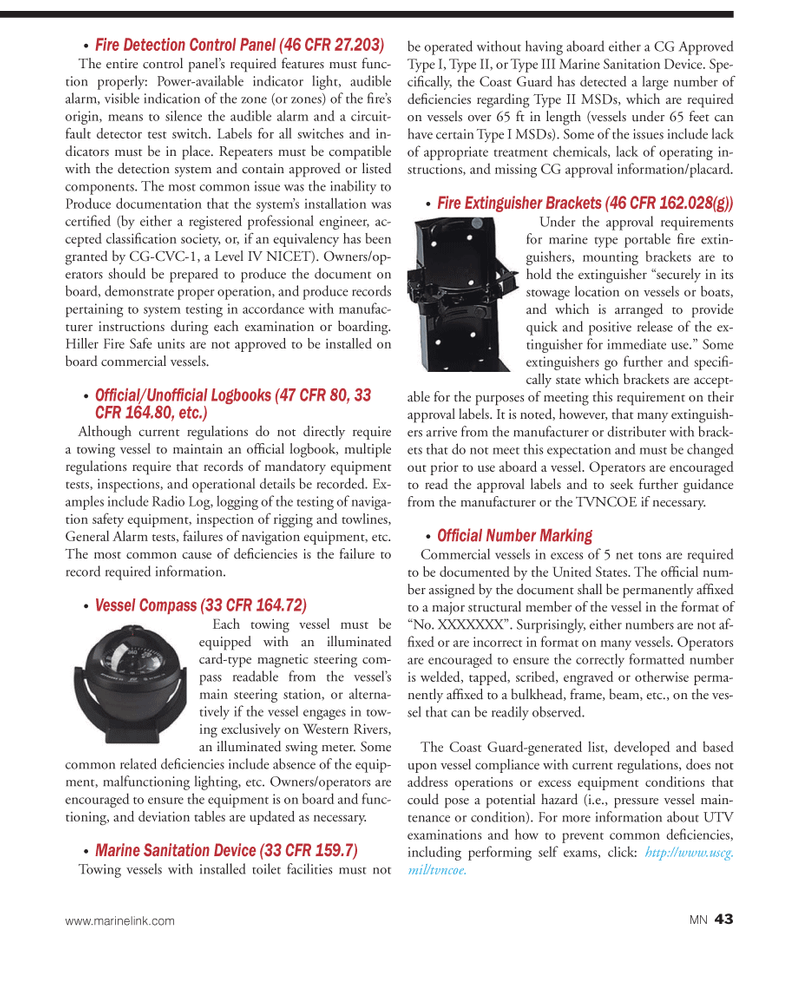
Page 43: of Marine News Magazine (August 2013)
Salvage & Response
Read this page in Pdf, Flash or Html5 edition of August 2013 Marine News Magazine
? Fire Detection Control Panel (46 CFR 27.203) The entire control panels required features must func- tion properly: Power-available indicator light, audible alarm, visible indication of the zone (or zones) of the ? res origin, means to silence the audible alarm and a circuit- fault detector test switch. Labels for all switches and in-dicators must be in place. Repeaters must be compatible with the detection system and contain approved or listed components. The most common issue was the inability to Produce documentation that the systems installation was certi? ed (by either a registered professional engineer, ac- cepted classi? cation society, or, if an equivalency has been granted by CG-CVC-1, a Level IV NICET). Owners/op- erators should be prepared to produce the document on board, demonstrate proper operation, and produce records pertaining to system testing in accordance with manufac- turer instructions during each examination or boarding. Hiller Fire Safe units are not approved to be installed on board commercial vessels. ? Of�À cial/Unof �À cial Logbooks (47 CFR 80, 33 CFR 164.80, etc.) Although current regulations do not directly require a towing vessel to maintain an of? cial logbook, multiple regulations require that records of mandatory equipment tests, inspections, and operational details be recorded. Ex- amples include Radio Log, logging of the testing of naviga-tion safety equipment, inspection of rigging and towlines, General Alarm tests, failures of navigation equipment, etc. The most common cause of de? ciencies is the failure to record required information. ? Vessel Compass (33 CFR 164.72) Each towing vessel must be equipped with an illuminated card-type magnetic steering com- pass readable from the vessels main steering station, or alterna-tively if the vessel engages in tow- ing exclusively on Western Rivers, an illuminated swing meter. Some common related de? ciencies include absence of the equip- ment, malfunctioning lighting, etc. Owners/operators are encouraged to ensure the equipment is on board and func- tioning, and deviation tables are updated as necessary. ? Marine Sanitation Device (33 CFR 159.7) Towing vessels with installed toilet facilities must not be operated without having aboard either a CG Approved Type I, Type II, or Type III Marine Sanitation Device. Spe- ci? cally, the Coast Guard has detected a large number of de? ciencies regarding Type II MSDs, which are required on vessels over 65 ft in length (vessels under 65 feet can have certain Type I MSDs). Some of the issues include lack of appropriate treatment chemicals, lack of operating in- structions, and missing CG approval information/placard. ? Fire Extinguisher Brackets (46 CFR 162.028(g)) Under the approval requirements for marine type portable ? re extin- guishers, mounting brackets are to hold the extinguisher securely in its stowage location on vessels or boats, and which is arranged to provide quick and positive release of the ex- tinguisher for immediate use.? Some extinguishers go further and speci? -cally state which brackets are accept- able for the purposes of meeting this requirement on their approval labels. It is noted, however, that many extinguish- ers arrive from the manufacturer or distributer with brack- ets that do not meet this expectation and must be changed out prior to use aboard a vessel. Operators are encouraged to read the approval labels and to seek further guidance from the manufacturer or the TVNCOE if necessary. ? Of�À cial Number Marking Commercial vessels in excess of 5 net tons are required to be documented by the United States. The of? cial num- ber assigned by the document shall be permanently af? xed to a major structural member of the vessel in the format of No. XXXXXXX?. Surprisingly, either numbers are not af- ? xed or are incorrect in format on many vessels. Operators are encouraged to ensure the correctly formatted number is welded, tapped, scribed, engraved or otherwise perma- nently af? xed to a bulkhead, frame, beam, etc., on the ves- sel that can be readily observed. The Coast Guard-generated list, developed and based upon vessel compliance with current regulations, does not address operations or excess equipment conditions that could pose a potential hazard (i.e., pressure vessel main- tenance or condition). For more information about UTV examinations and how to prevent common de? ciencies, including performing self exams, click: http://www.uscg. mil/tvncoe.www.marinelink.com MN 43MN August2013 Layout 32-49.indd 437/23/2013 7:27:35 PM

 42
42

 44
44
